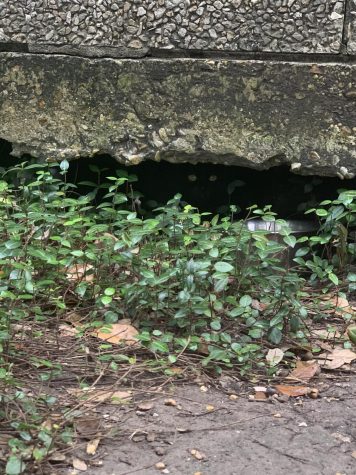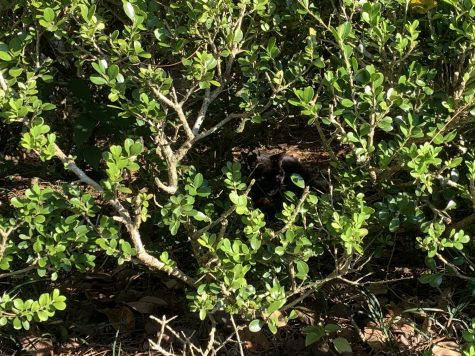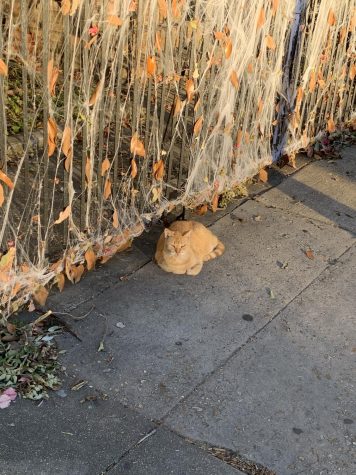Feral cats in New Orleans raise concerns
December 13, 2020

Cats prowl the streets and corners of New Orleans. They hide in bushes and retreat under buildings. They go through dumpsters, scavenging for food. No matter where you go, you’ll find cats that have called the city their home.
There’s an estimate of 146 million cats living in the United States. Although most cats stay indoors, some live outdoors, making it easier for them to come and go as they please. Nearly half of them are feral or unowned.
According to the Humane Society of the United States, nearly two percent of the community cat population has been spayed or neutered.
Bob Thomas, director of the Center for Environmental Communication, warned against the overpopulation of community cats in urban areas.
“What do you think they’ve been doing while they’ve been gone? Well, they’re hooking up with other cats!” Thomas said.
The Humane Society said that female cats can become pregnant “as early as five months of age.” Despite 85% of household cats being spayed or neutered, most of them gave birth before undergoing the procedure.
“If the cats are out there and they’re not fixed, they’re gonna mate and they’re gonna make kittens,” Zeus’ Rescues owner Michelle Inrgam said.
There are plenty of reasons why so many cats flock to the city. For example, there are cats that hang out behind the Orleans Room, according to mass communications junior and Loyola’s People for Animal Welfare and Service project leader Andi Robinson.
“[Loyola and Tulane]” definitely do dump a lot of their foods,” Robinson said.
Ingram said that cats usually flock to areas with an adequate food supply. They usually hang out behind restaurants, dumpsters and convenience stores.
“It’s a lot easier to knock over a trash can or to have somebody leave out a plate of food,” Ingram said.
Cats are also attracted to bodies of moving water. Since Robinson lives by the Mississippi River, she sees plenty of cats in her neighborhood.
“There are unfortunately rats and mice in the area, so they like to eat them,” Robinson said.
Although outdoor cats are mainly harmless, there are repercussions.
Thomas warned that the overbreeding of feral cats is endangering other species, including lizards, insects, mice and birds.
“Do [people] feel sorry for the birds that are being consumed, or for the other living animals in the neighborhoods that are being consumed? No, I don’t think they ever think about that,” Thomas said.
This is a problem for him, especially since he is a bird feeder. Sometimes, he walks into his backyard to check on the birds, only to find a pile of feathers greeting him on the ground.
“Everytime I look out there and see a cat in the backyard, I shoo it away. It doesn’t matter – it’s gonna be back,” Thomas said.
According to Thomas, the debate on the growing cat population is a “constant battle.” On one hand, there are cat lovers who get defensive when people say that cats should be kept indoors. On the other hand, there are nature lovers who get upset when they see cats eating other species.
Thomas said that humans are responsible for the breeding problem and need to come up with better ways on how to solve it.

The Louisiana Society for the Prevention of Cruelty to Animals explained that removing cats from their homes won’t help curb the feral population because of a phenomenon called the “vacuum effect,” meaning dozens of cats will flock to those areas once they’re vacated.
Ingram believes that the best way to keep the community cat population under control is for people to get their pet cats neutered or spayed.
“If you have an area like campus that doesn’t have a TNR program or a large feral cat colony, they’re just going to keep staying there,” Ingram said. “They’re gonna keep mating, multiplying and just staying there, and the problem gets worse and worse.”
SPCA has a Trap-Neuter-Release program that helps keep the number of feral and stray cats from growing. They use traps to catch the cats, send them to a veterinarian to be spayed or neutered, vaccinated and ear tipped, and they return them to their homes. It is considered to be the most humane method for controlling the cat population.

Zeus’ Rescues also has a spay/neuter program where they set traps to capture the mother and send them to the shelter to undergo the procedure, according to Ingram. Afterwards, they look after the kittens that are left behind.
Ingram said that the number of cats being born would be under control if there was more funding for spay/neuter programs.
“If we have an aggressive spay/neuter program that is affordable and easy for people to do, we would reduce the population of unwanted cats on the streets immediately,” Ingram said.
Thomas thinks that if more people took better care of their cats, it wouldn’t be such a problem.
“I’m in favor of people controlling their animals in their own homes,” Thomas said.
Cat traps are available on the Louisiana SPCA’s website. They should also call to make a spay/neuter appointment at the Community Clinic after they catch one.
“I really wish we could get the cats and take care of them and find a home for them,” Robinson said.








Matthew • Feb 7, 2022 at 10:53 am
What a completely stupid concept. This simply puts these imported predators back where they continue to kill our native birds and annoy neighbors. The release part is an irresponsible practice.
Dee • Dec 13, 2020 at 2:23 pm
There’s a lot of wild and loose people living on the streets which are causing most of the problem. These people are otherwise known as homeless, but most of them are there by choice because of drug or alcohol problems that they do not want to fix.
They are treated well buy some restaurants on some Churches who do daily handouts, they can also go other places and get food for free, and it has been well known biamp servers that if they don’t like something they’ll throw it on the ground. This has caused a rat problem.
So when you have rats you need cats to get rid of them. I’d much rather see cats outside than rats.
Imagine if you had a family member that was using very badly and was not being responsible and you warned them many times that if they didn’t get a job and start being responsible you were going to have to put them out on the street. So these people who are out on the street are now being enabled by all the people who come through the city and maybe even locals that give them money. And with talking to a lot of these people over the years I have found that a lot of them get well more than $100 a day and they have plenty of money but they’re living for free, causing a lot of debris, and being obnoxious in some cases 2 passers-by.
Lander did no good by doing that housing giveaway, because a lot of the people who got the houses still go out on the street and beg and they’re not even at their house much, because of the fact that if they did get a job they have to pay some of the rent and utilities so they’d rather just live off the government with their free house and keep on going with their lifestyle of use and abuse not only of alcohol and or drugs, but by their lies to people that they either lost everything in a fire, or they lost their job, Etc., but yet they continue to stay on the streets earning all that money for years.
And then the city has to pay out for maintenance and cleaning and carrying away debris and trash, while the rats Run free and then people want to pick on the cats.
First of all if Mayor Landrieu would have taken up the project Nola owner 4 his very good price very good cameras that see criminals and other people who cause disturbances, very clearly, a lot of the crime would be eliminated.
And this includes people who hang out on the streets because they commit crimes as well. I’m not saying all of them do but I have met a lot of people who have told me things, and these people used to live on the streets and got their act together, and would be the first ones to say it’s not handouts that help them but it was their change of mind of living like that.
So the first step would be to take up the deal that the project Nola owner made and get very good cameras put all over, take a bite out of lots of crime and criminal activity, and start charging anybody who staying on the street with a tent or anything else money to be there. And then you will see that they quickly find some other place to go besides being on the sidewalks and causing problems with the food, garbage & possessions that attract rats.
And with feral cats being caged and fixed it would greatly reduce the future populations of cats, but I don’t know why people would be so afraid of cats when mice and rats are a lot more caustic to not only the environment, the sewage, and People’s Health.
It’s amazing that through this 2020 obstacles, and how the mayor has shut down bars unfairly, when she could have very easily close the streets to traffic and allowed people to have their tables and chairs out on the streets so they could still remain open and serve people, as they did in New York City. But through all of this and through all of the problems that any City faces, and ever since the Katrina and other hurricanes have happened, not one mayor has even said anything about how rats cause diseases. The mayor hasn’t even mentioned that this year, and how do we know rats aren’t carriers of this disease that supposedly is on the loose.